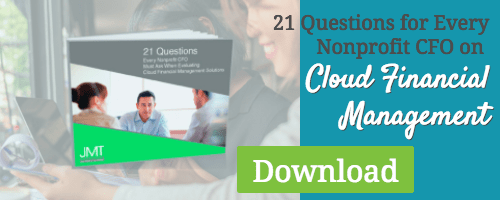If you’re an IT Director or CIO at a nonprofit organization, you may be experiencing something that sounds a little like this:
In the last few years, you have moved a lot of systems from your internal network servers. Your Development department has migrated to a cloud-based donor management system like Salesforce. Your Program people use a cloud-based tool to track metrics about your services. Your Grants people use a cloud-based program for grant application and management. Even all your office people are now using cloud-based Google Mail.
You have successfully eliminated the cost, risk, and burden of maintaining all these systems on your local network. Your once-crowded server room now has so much room you could fit an extra cubicle in there. But, there in the corner of the room still sits a lone server. Flashing at you every time you walk in, you’re reminded of the needed maintenance updates.
This server houses the accounting software your Finance department purchased to be ready for Y2K—and it’s still in use today!
For the past 26 years, JMT Consulting has worked in financial management for nonprofits. In that time, we’ve seen incredible advancements in technology. From floppy disks and DOS to the Windows revolution to Y2K, to SQL Servers and now the cloud—we’ve seen it all. Through all these changes, we have encountered many nonprofits who show reluctance to migrate to new technology.
Common misconceptions about adopting new technology for nonprofits
Often, nonprofit finance departments hesitate to adopt new technology tools because they believe the following misconceptions:
New technology is unfit for the unique needs of nonprofits.
New technology platforms are all well and good, but they are worthless if they can’t perform the intricacies of nonprofit accounting. (automated fund accounting, complex indirect allocations, segmentation of revenues/expenditures by grants and programs, etc.)
Technology changes will disrupt a mission-critical system.
The current system, while not the latest and greatest, still works. If something goes wrong in a migration, and Finance cannot function, then the organization’s survival is at risk.
We can’t afford new technology.
The cost of new systems, especially when paid for by annual subscription, can seem like a lot compared to the small maintenance/support payments with the legacy system.
Migrations add to the already overflowing workload of the Finance team.
Many nonprofit Finance professionals work long hours already and don’t relish the idea of more work.
The migration project will take too much of our team’s time.
Many people have had terrible experiences related to IT projects. If a CFO’s last experience with a migration was a protracted, two-year implementation which ended up at 300% of the budget, they may assume that implementation of a system today will be similar.
Fortunately, these ideas are myths about adopting new technology.
There are solutions out there for nonprofits. And those solutions don’t have to take all your time, go over budget, or leave you stuck without mission-critical systems.
Of these misconceptions, the most difficult for IT to overcome tends to be the first. If you’re in IT, your area of expertise is technology and systems, and probably not accounting. You may know enough about accounting to know that most accounting software systems cannot perform the complexities of nonprofit financial management. And the ones that can are typically yesterday’s technology (maybe like that which sits on your server at this moment!).
And so you are stuck.
How can you bridge the gap between your technology roadmap and nonprofit accounting compliance requirements?
JMT Consulting can be that bridge for you. Focusing on nonprofit financial management systems, our most important job is to keep apprised of technology changes and to evangelize those changes to nonprofits, showing the best solutions for them. Technology is expanding at an exponential pace. That means the organizations who don’t keep up may risk their very survival.
We evaluate the marketplace of available technology tools for nonprofits. Then, we select only those which meet our rigid requirements. Most ERP systems in the market today cannot perform basic nonprofit accounting. While they may have some great new technology, the end user still reverts back to manual processes. Even with shiny new technology, they’re using spreadsheets to produce basic compliance reports.
It is understandable, then, that a CFO may look at modern technology features as “nice to have.” They know their legacy system can at least do basic nonprofit accounting.
Unfortunately, this can mean the organization misses out on some benefits of modern platforms. This includes tight integration with other systems (Salesforce.com), Key Performance Indicators (KPIs), incorporating computations between dollars and non-financial metrics, automation of corporate credit card usage, electronic purchase orders, and more.
You may find companies focused on business technology or accounting or nonprofits. But there simply isn’t another company focused on the intersection of these elements. As you consider the technology roadmap for your organization, consider JMT. We will be there to help find the right solution to meet your organization’s unique needs.
Get more insight on equipping your Finance department with the right tools for nonprofit accounting and the unique needs that come along with it. Download the ebook developed specifically for the Nonprofit CFO: 21 Questions for Every Nonprofit CFO Must Ask When Evaluating Cloud Financial Management Solutions.


